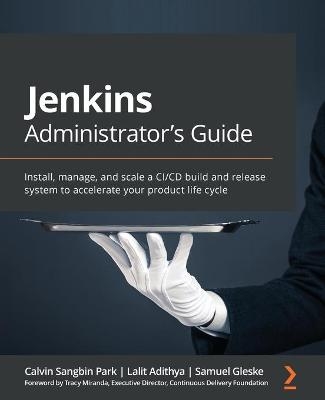
Jenkins Administrator's Guide
Packt Publishing Limited (Verlag)
978-1-83882-432-7 (ISBN)
Build and manage a production Jenkins instance, complete with CI/CD pipelines using GitHub and Docker Hub, Jenkins Configuration as Code, Shared Libraries, Script Security, and optimization guides
Key Features
Set up production-grade Jenkins and CI/CD pipelines with GitHub and Docker Hub integrations
Manage, protect, and upgrade a production Jenkins instance regardless of its size and the number of users
Scale a Jenkins instance using advanced optimization tips, tricks, and best practices
Book DescriptionJenkins is a renowned name among build and release CI/CD DevOps engineers because of its usefulness in automating builds, releases, and even operations. Despite its capabilities and popularity, it's not easy to scale Jenkins in a production environment. Jenkins Administrator's Guide will not only teach you how to set up a production-grade Jenkins instance from scratch, but also cover management and scaling strategies.
This book will guide you through the steps for setting up a Jenkins instance on AWS and inside a corporate firewall, while discussing design choices and configuration options, such as TLS termination points and security policies. You'll create CI/CD pipelines that are triggered through GitHub pull request events, and also understand the various Jenkinsfile syntax types to help you develop a build and release process unique to your requirements. For readers who are new to Amazon Web Services, the book has a dedicated chapter on AWS with screenshots. You'll also get to grips with Jenkins Configuration as Code, disaster recovery, upgrading plans, removing bottlenecks, and more to help you manage and scale your Jenkins instance.
By the end of this book, you'll not only have a production-grade Jenkins instance with CI/CD pipelines in place, but also knowledge of best practices by industry experts.
What you will learn
Set up a production-grade Jenkins instance on AWS and on-premises
Create continuous integration and continuous delivery (CI/CD) pipelines triggered by GitHub pull request events
Use Jenkins Configuration as Code to codify a Jenkins setup
Backup and restore configurations and plan for disaster recovery
Plan, communicate, execute, and roll back upgrade scenarios
Identify and remove common bottlenecks in scaling Jenkins
Use Shared Libraries to develop helper functions and create new DSLs
Who this book is forThis book is for both new Jenkins administrators and advanced users who want to optimize and scale Jenkins. Jenkins beginners can follow the step-by-step directions, while advanced readers can join in-depth discussions on Script Security, removing bottlenecks, and other interesting topics. Build and release CI/CD DevOps engineers of all levels will also find new and useful information to help them run a production-grade Jenkins instance following industry best practices.
Calvin Sangbin Park is a CI/CD DevOps engineer in NVIDIA. He's been using Jenkins throughout his career to automate the builds for Arduino Maker boards, Android tablets, enterprise software packages, and even firmware for an industrial laser for etching CPUs. Lately, he's been focusing on Kubernetes, monitoring, and process visualizations. He plans to contribute to the open-source community by developing a plugin that optimizes the Kubernetes cluster management. Lalit Adithya is a software engineer with the DevOps team at NVIDIA. He has built code commit to production pipelines using Jenkins and GitHub actions. He has built and scaled business-critical applications that serve several thousand requests every minute. He has also built frameworks that have boosted developer productivity by abstracting away the complexities of networking, request/response routing, etc. He knows the ins and outs of several public cloud platforms and can architect cost-effective and scalable cloud-native solutions. Sam Gleske has been a Jenkins user and contributor for 10 years since 2011. He's contributed documentation, plugins, and discovered security issues. Some notable plugins Sam has maintained include: Slack plugin, GHPRB plugin, GitHub Authentication plugin, and a half dozen others. Sam has presented on and shared scripts for the Script Console documentation including being the primary author of its wiki page. Since 2014 Sam has been developing Jervis: Jenkins as a service which enables Jenkins to scale to more than 4,000 users and 30,000 jobs in a single Jenkins controller. Jervis emphasizes full self-service within Jenkins for users while balancing security. I dedicate this to my wife Kristie whose support for me made this possible.
Table of Contents
Jenkins Infrastructure with TLS/SSL and Reverse Proxy
Jenkins with Docker on HTTPS on AWS and inside a Corporate Firewall
GitOps-Driven CI Pipelines with GitHub
GitOps-Driven CD Pipelines with Docker Hub and More Jenkinsfile Features
Headfirst AWS for Jenkins
Jenkins Configuration as Code (JCasC)
Backup and Restore and Disaster Recovery
Upgrading the Jenkins Controller, Agents, and Plugins
Reducing Bottlenecks
Shared Libraries
Script Security
| Erscheinungsdatum | 29.12.2021 |
|---|---|
| Verlagsort | Birmingham |
| Sprache | englisch |
| Maße | 75 x 93 mm |
| Themenwelt | Mathematik / Informatik ► Informatik ► Software Entwicklung |
| ISBN-10 | 1-83882-432-4 / 1838824324 |
| ISBN-13 | 978-1-83882-432-7 / 9781838824327 |
| Zustand | Neuware |
| Haben Sie eine Frage zum Produkt? |
aus dem Bereich


